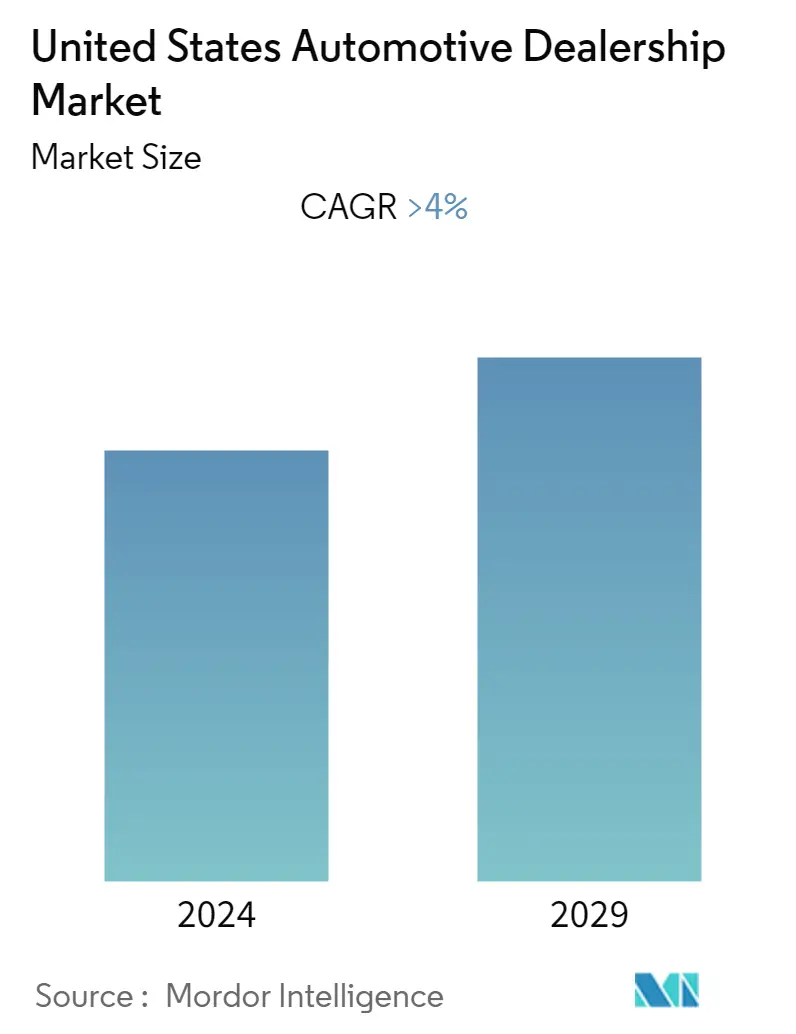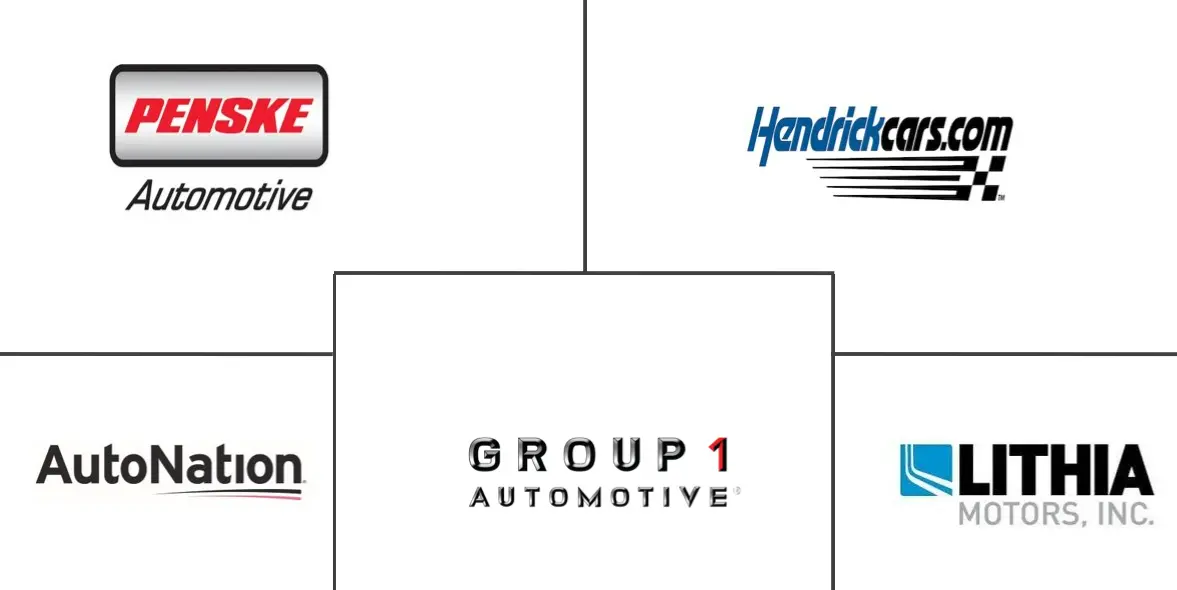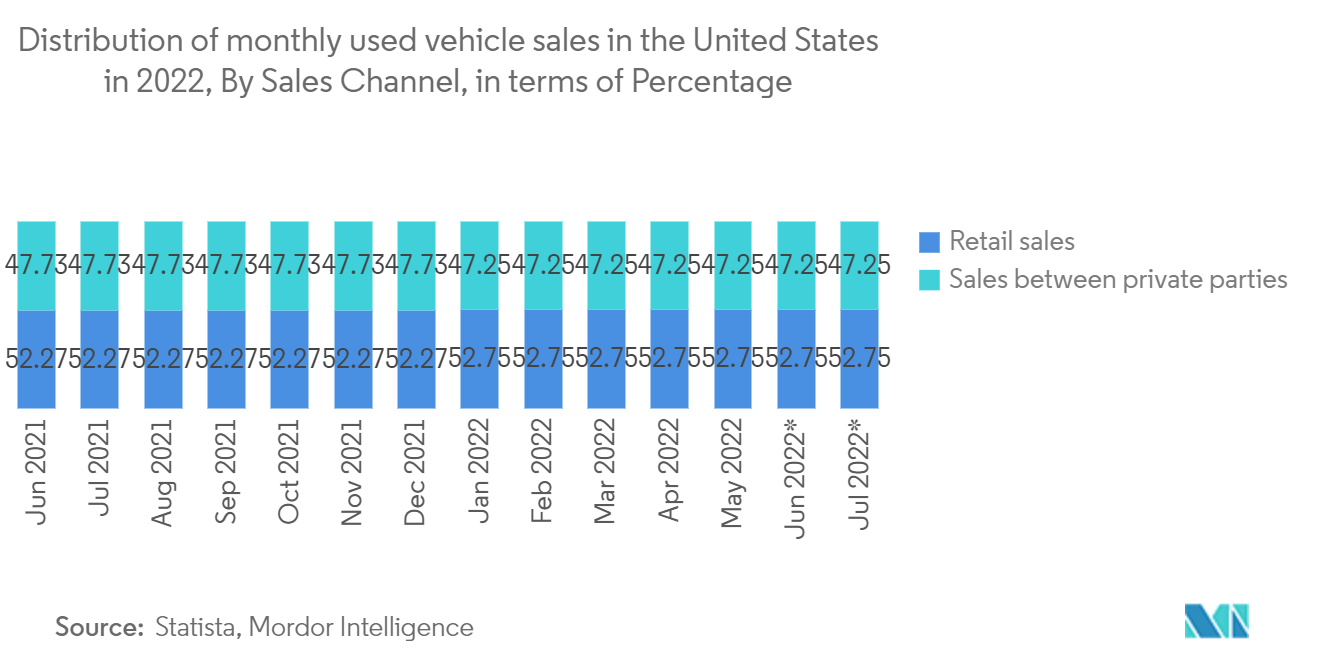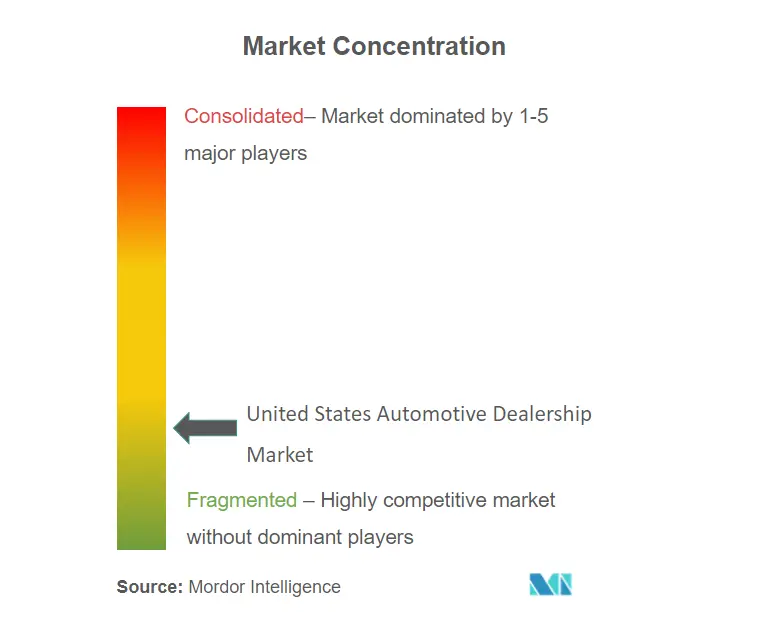US Automotive Dealership Market Size

| Study Period | 2019 - 2029 |
| Base Year For Estimation | 2023 |
| Forecast Data Period | 2024 - 2029 |
| Historical Data Period | 2019 - 2022 |
| CAGR | 4.00 % |
| Market Concentration | Low |
Major Players
*Disclaimer: Major Players sorted in no particular order |
US Automotive Dealership Market Analysis
The US automotive dealership market is expected to reach USD 257.3 billion, registering a CAGR of above 4% over the next five years.
The COVID-19 pandemic harmed the growth of the US automotive dealership market as the shutdown and lockdown of manufacturing activities and dealerships of major OEMs resulted in a halt in demand in the first half of 2020. However, as restrictions eased by the end of the year, the recovery of key franchised and non-franchised dealers across the country in the wake of growing new and used car sales helped the market regain its momentum.
As the automotive industry expands, substantial investments in new technologies, such as connected cars, electric cars, autonomous cars, etc., by major manufacturers are expected to support the market's growth in the medium term. In addition, the growing presence of automotive dealers, coupled with consumer inclination towards a hassle-free buying experience, is anticipated to further enhance the market growth in the coming years.
For instance, according to NADA's mid-year 2022 report, the nation's 16,752 franchised light-vehicle dealers sold 6.8 million light-duty vehicles, and total light-vehicle dealership sales stood at USD 618 billion. In addition, in 2021, motor vehicle parts stores and automobile dealers witnessed an increase in revenue of around 23% over the previous year. US motor vehicle and part dealers generated revenue of almost USD 1.53 trillion from retail trade.
However, factors such as inventory shortages are caused by numerous supply chain disruptions. Also, the growing preference of consumers for online purchases over showroom experience poses challenges for market growth. Despite such challenges, technological advancements in dealer management systems, such as Artificial Intelligence (AI), cloud computing, data analytics, etc., are expected to further propel demand in the market.
For instance, in June 2022, Advanced Business Computers of America Inc. (ABCoA), a software-as-a-service company entrenched in the used car industry and known for Deal Pack® and cyclCRM, announced new and revolutionary dealer management software (DMS) called DST Dealership Sales Tools.
Further, factors such as the launch of standalone stores, the adoption of omnichannel retail strategies, and the growing consumer interest in certified used cars, coupled with the active expansion of the dealership network in the country by key OEMs, are expected to support the growth of the market in the future.
US Automotive Dealership Market Trends
This section covers the major market trends shaping the US Automotive Dealership Market according to our research experts:
Rising Focus of Automotive Dealers on Enhancing Consumer Experience and Dealer Network to Drive Demand
The automotive and mobility industries have certainly been among the hardest hit during the COVID-19 pandemic. However, as restrictions ease across the country, vehicle dealerships are becoming busier, and many are eager to buy more inventory. Several consumers have started to choose personal transportation over public transportation as a result of the pandemic, which spurred opportunities for dealers who are most inclined to offer financial services for new and used vehicles. Thus, with a variety of financing options available in the country, the dealership network is expected to flourish in the coming years.
For original equipment manufacturers (OEMs), car dealers remain a vital link in the chain, holding the keys to local and meaningful customer interaction and playing a crucial role in the aftermarket and ongoing consumer interaction. Over the last decade, large dealership networks have been able to maintain margins and build the scale necessary to invest and adapt.
For instance, in November 2022, Kia announced the launch of the revised 2023 Telluride SUV as it makes its way to dealerships across the United States. The 2023 Telluride builds upon the success of the original with two new rugged trim levels (X-Line and X-Pro) that help the Telluride track further through urban, suburban, off-road, and ranch-style landscapes.
As a result of such an optimistic environment, companies are focusing on meeting the expectations of authorized and unauthorized dealers and making themselves available to provide custom solutions. For instance, in March 2021, HGreg.com, one of the fastest-growing automotive groups in North America, acquired Buena Park Nissan and Puente Hills Nissan, two established car retailers located in the Greater Los Angeles area. The acquisition enables HGreg.com to continue its growth plans for the West Coast, expand its inventory of quality pre-owned vehicles, and, ultimately, offer the omnichannel car buying journey that it has committed to streamlining.
In addition, growing electric mobility and the fast adoption of new technologically equipped vehicles are expected to create an optimistic environment in the market. Such trends in the market pose a positive outlook for demand over the coming years.

Rising Used Car Sales Expected to Augment Market Growth in the Next Five Years
Due to unprecedented circumstances, such as global semiconductor shortages and supply chain disruptions in the wake of the ongoing Russia-Ukraine war, used cars are gaining popularity in the United States. This has impacted new car sales, reducing the positive outlook for used vehicles in the country. In addition, the inability of customers to buy new cars became one of the reasons for the growing used car sales volume, which is complemented by the investments made by industry participants to establish their dealership network in the market. These dealership networks helped market participants to brand and make used car options viable.
For instance, used vehicles accounted for around 36.7% of sales generated by franchised car dealerships in 2021, up from about 33% the previous year. The contribution of new vehicles fell from 55% in 2020 to 52.2% in 2021. This shift toward used vehicles is linked to the rising price of new vehicles in the United States.
Further, factors such as affordability, the availability of used cars, and the requirement for personal mobility, are expected to help dealers operating in the United States to emerge in the coming years. For instance, in October 2021, used car dealer CarLotz announced that it expanded North Texas with a new hub in Plano. This marks its first location in the metro area and second in the state as part of its expansion plans. The company has 20 retail locations across California, Colorado, Florida, Georgia, Illinois, Missouri, North Carolina, Tennessee, Texas, Virginia, and Washington. Other retail locations are planned for Alabama and Nevada by the end of 2022.
Various leading companies have set up online and offline stores to offer seamless used car buying experiences. For instance, in September 2020, AutoNation Inc. expanded its pre-owned vehicle store and opened two new stores in the USA Denver market. The organization also announced its goal to open 130 AutoNation Inc. stores by 2026. Such developments and trends are expected to enhance the overall growth of the market in the coming years.

US Automotive Dealership Industry Overview
The US automotive dealership market is considered to be fragmented owing to its competitive nature, and the presence of a large number of players operating in it across the country. These players are expected to focus on the development of new products and innovations, which will help them expand their product portfolio and attract a large number of consumers not only across the country but also in the region.
For instance, in April 2021, Penske Automotive Group Inc., a diversified international transportation services company, and Premier Truck Group ("PTG"), its wholly-owned commercial vehicle subsidiary, acquired Kansas City Freightliner ("KCFL"), a retailer of medium and heavy-duty commercial trucks. The acquisition adds five full-service dealerships, four parts and service centers, and two collision centers located in Kansas and Missouri to the company's existing operation.
In December 2021, Asbury Automotive Group Inc., one of the largest automotive retail and service companies in the United States, acquired LHM, which includes Larry H. Miller Dealerships (LHM Dealerships) and Total Care Auto, Powered by Landcar (TCA) from the Larry H. Miller Group of Companies (LHM), acquiring 54 new vehicle dealerships, seven used vehicle dealerships, 11 collision centers, a used vehicle wholesale business and an F&I product provider.
In August 2020, Hendrick Automotive Group acquired Neuwirth Chrysler Dodge Jeep Ram FIAT in Wilmington from Neuwirth Motors. Hendrick's Wilmington operations include Jeff Gordon Chevrolet. In North Carolina, the company has 41 dealerships and 60 franchises. The company has 95 dealership locations, 26 collision centers, and four accessory distributors in 14 states.
US Automotive Dealership Market Leaders
-
Penske Automotive Group
-
Hendrick Automotive Group
-
Auto Nation Inc.
-
Group 1 Automotive Inc.
-
Lithia Motors Inc.
*Disclaimer: Major Players sorted in no particular order

US Automotive Dealership Market News
- July 2022: Lithia & Driveway (LAD) continued its US expansion by buying nine dealerships in southern Florida and one in Nevada, which are expected to add nearly USD 1 billion in annual revenue for the company. LAD also announced its expansion in Las Vegas, Nevada, with the addition of Henderson Hyundai and Genesis. With this purchase, LAD becomes the sole owner of the Hyundai and Genesis stores in the greater metro area.
- March 2022: Group1 Automotive Inc. announced that it completed a USD 2.0 billion five-year revolvings syndicated credit facility with 21 financial institutions that will expire in March 2027 and can be expanded to USD 2.4 billion total availability. The six manufacturer-affiliated finance companies are Mercedes-Benz Financial Services USA LLC, Toyota Motor Credit Corporation, BMW Financial Services NA LLC, American Honda Finance Corporation, VW Credit Inc., and Hyundai Capital America Inc.
- January 2022: Penske Automotive Group expanded its presence in the Austin/Round Rock market in Texas with the grand opening of the Honda Leander. The new dealership, located in Leander, Texas, is the retailer's 14th Honda store overall and is its ninth dealership in the market.
- January 2022: Sonic Automotive Inc., one of the nation's largest automotive retailers, acquired Sun Chevrolet in Chittenango, New York. Sonic also acquired Caputo's three used car locations in December 2021. The Chittenango location was the only new car dealership.
US Automotive Dealership Market Report - Table of Contents
1. INTRODUCTION
- 1.1 Study Assumptions
- 1.2 Scope of the Study
2. RESEARCH METHODOLOGY
3. EXECUTIVE SUMMARY
4. MARKET DYNAMICS
- 4.1 Market Drivers
- 4.2 Market Restraints
-
4.3 Industry Attractiveness - Porter's Five Forces Analysis
- 4.3.1 Threat of New Entrants
- 4.3.2 Bargaining Power of Buyers/Consumers
- 4.3.3 Bargaining Power of Suppliers
- 4.3.4 Threat of Substitute Products
- 4.3.5 Intensity of Competitive Rivalry
5. MARKET SEGMENTATION (Market Size in Value USD billion)
-
5.1 By Type
- 5.1.1 New Vehicle dealership
- 5.1.2 Used Vehicle dealership
- 5.1.3 Parts and Services
- 5.1.4 Finance and Insurance
-
5.2 By Retailer
- 5.2.1 Franchised Retailer
- 5.2.2 Non-Franchised Retailer
-
5.3 By Vehicle Type
- 5.3.1 Passenger Cars
- 5.3.2 Commercial Vehicles
6. COMPETITIVE LANDSCAPE
- 6.1 Vendor Market Share
-
6.2 Company Profiles
- 6.2.1 Group 1 Automotive Inc.
- 6.2.2 AutoNation Inc.
- 6.2.3 Penske Automotive Group
- 6.2.4 Lithia Motors Inc.
- 6.2.5 Hendrick Automotive Group
- 6.2.6 Asbury Automotive Group Inc.
- 6.2.7 Larry H. Miller Dealerships
- 6.2.8 Ken Garff Automotive Group
- 6.2.9 Staluppi Auto Group
- 6.2.10 Sonic Automotive Inc.
- *List Not Exhaustive
7. MARKET OPPORTUNITIES AND FUTURE TRENDS
** Subject To AvailablityUS Automotive Dealership Industry Segmentation
A car dealership, or car dealer, is a business that sells new or used cars, at the retail level, based on a dealership contract with an automaker or its sales subsidiary. It can also carry a variety of certified pre-owned vehicles. Car dealerships employ automobile salespeople to sell their automotive vehicles, provide maintenance services for cars, and employ automotive technicians to stock and sell spare automobile parts. They also process warranty claims. The US automotive dealership market has been segmented by type (new vehicle dealership, used vehicle dealership, parts and services, and finance and insurance), retailer (franchised retailer and non-franchised retailer), and vehicle type (passenger cars and commercial vehicles). The market size and forecast for each segment have been calculated based on value (USD billion).
| By Type | New Vehicle dealership |
| Used Vehicle dealership | |
| Parts and Services | |
| Finance and Insurance | |
| By Retailer | Franchised Retailer |
| Non-Franchised Retailer | |
| By Vehicle Type | Passenger Cars |
| Commercial Vehicles |
US Automotive Dealership Market Research FAQs
What is the current United States Automotive Dealership Market size?
The United States Automotive Dealership Market is projected to register a CAGR of greater than 4% during the forecast period (2024-2029)
Who are the key players in United States Automotive Dealership Market?
Penske Automotive Group, Hendrick Automotive Group, Auto Nation Inc., Group 1 Automotive Inc. and Lithia Motors Inc. are the major companies operating in the United States Automotive Dealership Market.
What years does this United States Automotive Dealership Market cover?
The report covers the United States Automotive Dealership Market historical market size for years: 2019, 2020, 2021, 2022 and 2023. The report also forecasts the United States Automotive Dealership Market size for years: 2024, 2025, 2026, 2027, 2028 and 2029.
What are the key drivers of the US Automotive Dealership Market?
Key factors driving the US Auto Dealership Market are a) Rising automotive sales b) Evolving consumer preferences c) Technological advancements in vehicle features and online sales platforms
United States Automotive Dealership Industry Report
The US auto dealership market and the United States automotive dealership market are witnessing substantial growth, driven by factors affecting both new and used vehicle segments. Market segmentation includes dealership type, retailer type, and vehicle type. New vehicle dealerships typically operate under franchise agreements to sell cars directly from manufacturers, whereas used vehicle dealerships specialize in the resale of pre-owned vehicles. Additionally, parts, services, finance, and insurance are integral to the dealership ecosystem. The market features both franchised and non-franchised retailers, with franchised retailers usually selling under manufacturer agreements and non-franchised retailers offering various vehicle brands independently. The vehicle types covered range from passenger cars to commercial vehicles, addressing diverse consumer needs. Geographically, the market extends across different regions, each influenced by local economic conditions, consumer preferences, and technological advancements in vehicle manufacturing. For detailed statistics, market share, size, revenue growth rate, and a forecast outlook of the United States Automotive Dealership market, refer to Mordor Intelligence™ Industry Reports. Access a historical overview and receive a free report PDF download by visiting their website.



